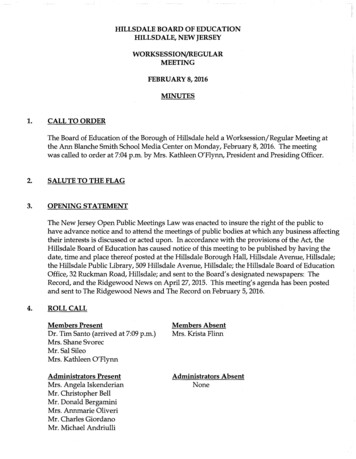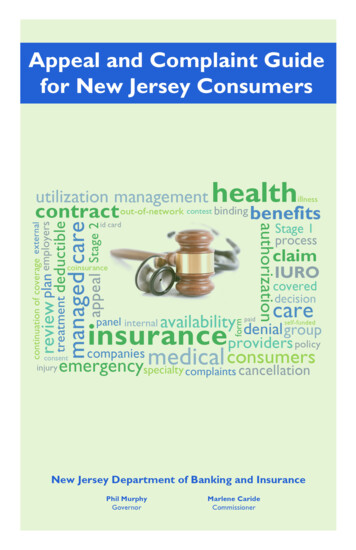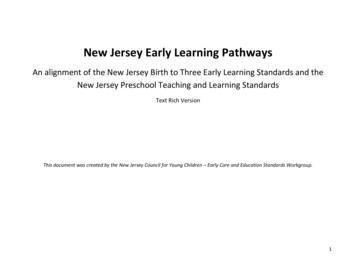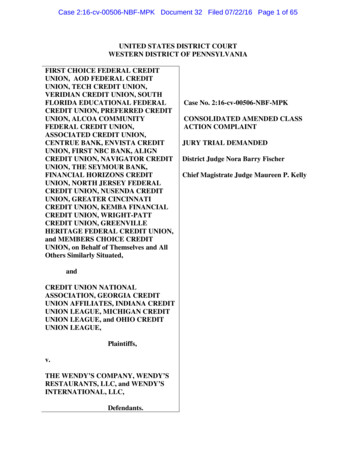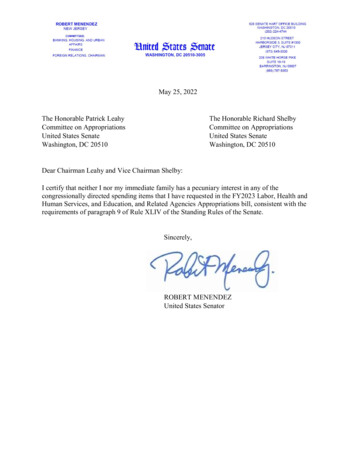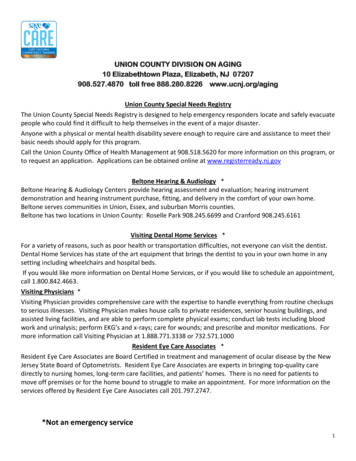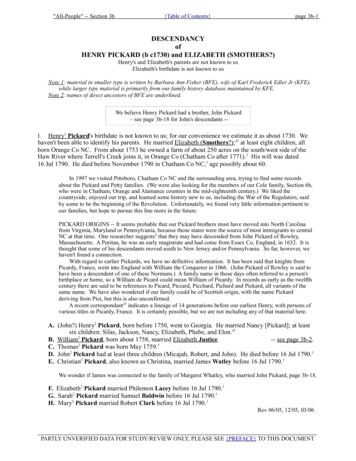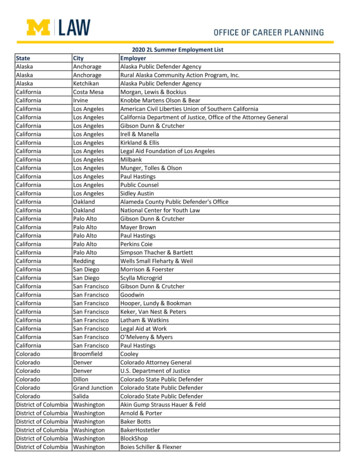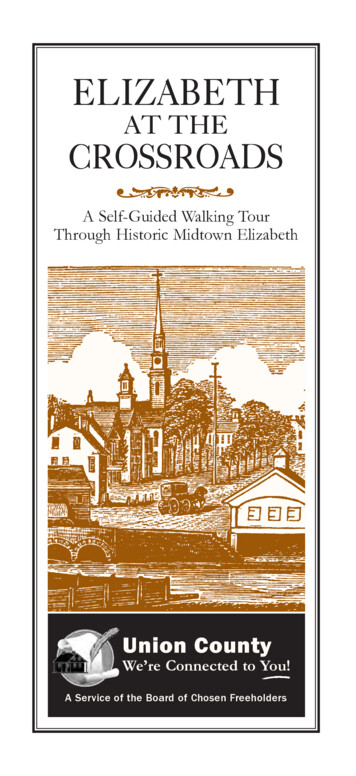
Transcription
ELIZABETHAT THECROSSROADSA Self-Guided Walking TourThrough Historic Midtown ElizabethUnion CountyWe’re Connected to You!A Service of the Board of Chosen Freeholders
COUNTY OF UNIONOffice ofCultural & Heritage Affairs Staff633 Pearl Street Elizabeth, NJ 07202(908) 558-2550 Fax: (908) 558-2652 NJ Relay 711Email: culturalinfo@ucnj.orgWebsite: www.ucnj.org/culturalThanks and appreciationare extended toKatherine Craig, Caretaker,Boxwood Hall State Historic Site,New Jersey Department of Environmental Protection,Division of Parks and Forestry,for researching and writing this bookletin cooperation with theUnion County Office of Cultural & Heritage Affairs,Department of Parks & Community Renewal.Boxwood Hall State Historic Site (Boudinot Mansion).1073 East Jersey Street, Elizabeth, New JerseyUsually open Monday - Friday9:00 a.m. to noon and 1:00 p.m. to 5:00 p.m.908-282-7617 (Call to confirm.)
ELIZABETHAT THECROSSROADSA Self-Guided Walking TourThrough Historic Midtown ElizabethDistance: Approx. 3 1/2 MilesThe information in this booklet iscorrect as of February 2010,but Elizabeth is a dynamic city,and change often happens quickly.Map courtesy of the Union County Historical Society
ELIZABETHAT THECROSSROADSPhoto Courtesy of the Union County Historical SocietyAgreat deal has changed since1664, when the unsettled landthat would become Union Countywas purchased from the Lenni LenapeIndians by a group of Englishmen.The area, named Elizabethtown afterthe wife of Sir George Carteret,proprietor of East Jersey, was thefirst permanent English settlement inNew Jersey and the provincial capitalof East Jersey.
By the mid-18th century, Elizabethtown had become one of the mostprominent cities in New Jersey. Inthe 1750s, Royal Governor JonathanBelcher established his residence inElizabethtown, making the town thecolonial capital.The 19th century transformedElizabethtown into a transportationhub as railroad lines, highways andsteamboat shipping converged inthe city. Originally part of EssexCounty, the area split off and wasincorporated as Union, the state’sfinal county, in 1857. All of what isnow Union County was once part ofthe Elizabethtown tract.Elizabeth at the Crossroads presents aself-guided walk through the streetsof historic mid-town Elizabeth. Thetour stops allow visitors to lingerand experience an era of the city’srich history and development as thepermanent seat of government ofthe County of Union.A map of the streetsin this tour can be found inthe center of this booklet onpages 16 & 17.
ELIZABETHAT THECROSSROADSA Self-Guided Walking Tour1Begin at the ELIZABETH PUBLICLIBRARY, 11 South Broad Street. Themain building was completed in 1912 andenlarged in 1925. The building was a gift ofAndrew Carnegie, the wealthy philanthropist.During the eighteenth century, the lot was thesite of the Red Lion Inn, where Washingtonwas entertained on April 23, 1789, beforeproceeding to Boxwood Hall (see # 28). Asyou stand facing the library, at the far end ofthe parking lot to your left is the Old Millsite. In 1669, John Ogden opened a gristmillnear the spot where South Broad Street nowcrosses the Elizabeth River. Until about 1900,the Elizabeth River was navigable to this point.This is the original settlement area; colonistswould sail up a river as far as possible as protection from weather and invasion. The riverbanks were contained for flood control around1985, but the river is still subject to the rise andfall of the tides.Early 20th Century view: Elizabeth Public Library,Union County Courthouse and First Presbyterian Church2
A Self-Guided Walk Through Historic Mid-Town Elizabeth2Early 20th Century view: Elizabeth Avenue seen fromthe Union County CourthouseCross Rahway Avenue (the street to yourright) going north. The street on yourright is ELIZABETH AVENUE—formerlyWater Street, and earlier, the King’s Highway.One of the oldest streets in North America,it may have been used by the Dutch beforeElizabethtown was settled. Legend says itwas an Indian trail before the Dutch came.It extends to the Arthur Kill, the narrowstrip of water that separates Elizabeth fromStaten Island, New York. During the AmericanRevolution, British and Tory raiders usedElizabeth Avenue as a direct route from StatenIsland to the center of Elizabethtown.UNION COUNTY COURTHOUSEEarlier courthouses occupied one half ofthis lot, the half farthest from the corner. Thecorner lot held a private house and later a hotelcalled the Sheridan House.The first borough courthouse (Elizabethwas part of Essex County and the countycourthouse was in Newark) was burned during a Tory raid in 1780. A new building waserected in 1797, but burned in 1808. The nextbuilding was enlarged in 1857 and became thecounty courthouse for Union County, separated that year from Essex County.The chronology of the current complex:Front portion:1903First Annex:1925Tower:1931-32New annex:1990 33
CROSSROADS OF ELIZABETHThe inscription is in Latin and means, “Thevoice of the people is the voice of God.”The cannon, cast in Strasburg in 1758 wascaptured and recaptured by the French andEnglish until 1779, when General AnthonyWayne recaptured Stony Brook. GeorgeWashington himself presented the cannon tothe troops from Elizabethtown, who broughtit home with them.BE VERY CAREFUL WHILEWALKING ON THIS BLOCK OFBROAD STREET—THE SIDEWALKIS VERY UNEVEN.As you walk along, notice the memorialplaques at the base of many of the trees.44THE FIRST PRESBYTERIAN CHURCHThe congregation was founded in1664, the year the first settlers arrived inElizabethtown. The original building, probably a simple Meeting House, was replacedin 1724. That structure was burned during araid on January 25, 1780. The raid was led byCornelius Hetfield, a Staten Island Tory originally from Elizabethtown, whose father was anElder of the church.A new building was completed in 1793;some of the exterior walls date from thatstructure. Aside from interior remodeling andredecorating over time, the building remainedessentially unchanged until 1899, when a tornado blew off the steeple. (It landed upsidedown, the point buried in the earth.) Thesteeple was replaced in the early 1900s, only tobe destroyed—along with the interior and theroof—in the great fire of June 25, 1946. Whilethe church was soon rebuilt, and the interior restored to a Colonial, rather than Gothicstyle, the church steeple was not replaced until2008. Both Elizabeth’s skyline and the townclock have been restored.The churchyard contains the graves of manynoted Elizabeth residents. One of the mostfamous is Rev. James Caldwell; his grave and
A Self-Guided Walk Through Historic Mid-Town ElizabethFirst Presbyterian Church: Before the 1946 Firethat of his wife Hannah are marked by theobelisk. The land between the iron fence andthe stone wall around the graveyard was knownas the Parade Ground. Local militia units usedit for military drills as late as the Civil War.THE FIRST PRESBYTERIAN CHURCHPARISH HOUSE, the red brick buildingon the corner, was erected in 1917.The original building on the site was openedin 1767 as a classical school, known as theAcademy. Aaron Burr was one of the earlystudents. Francis Barber was named headmaster in 1771; one of his pupils was AlexanderHamilton. Hamilton and Burr were close inage, but Hamilton was 15 when he startedhere; Burr had already graduated. Barber leftthe school to join the Continental Army. Hesurvived the Revolutionary War only to bekilled by a falling tree in late 1781.55
CROSSROADS OF ELIZABETHThe Academy was burned during a Britishraid on February 25, 1779. Rebuilt andreopened in 1787, it closed in 1834; the building then became the first “Session House” ofthe First Church. Rebuilt in 1863 and againin 1917, it has been used as a Parish House,offices and Sunday School and is now the centerof the congregation’s urban ministry.6Broad Street: Probably dating from the 1950sAcross Broad Street are two converted movietheaters. The REGENT THEATERbuilding, 41 Broad Street, has painted cementgargoyles along its upper facade. The buildingis the site of the home and printing office ofShepard Kollock, founder of the New JerseyJournal, later the Elizabeth Daily Journal,which published for over 200 years, until 1991.Past the brick-faced discount store, once theNew Theater is the UNION COUNTYSAVINGS BANK, 61 Broad Street, foundedin 1874.67A8As you cross Caldwell Place continuingnorth, you are on the site of Elizabeth’sfirst bucket brigade cistern. Wells were dugaround the city to provide fire protection forthe residents in the days before fire engines.cross the street is ST. JOHN’SEPISCOPAL CHURCH which wasestablished in 1706. The original brick building was enlarged several times; the currentstructure in the Gothic style was erected in
A Self-Guided Walk Through Historic Mid-Town Elizabeth1859. The grave of Jonathan Dayton, Elizabethnative, Revolutionary War veteran and youngestsigner of the Constitution, is located under thechurch.The most famous rector was the Rev. ThomasChandler who served, although not continuously, from 1751-1790. He fled to England during the American Revolution, pleading ill health,but there were rumors that he and his wife weresuspected of spying for the British. His son,William, stayed in New Jersey and attained therank of Captain in the New Jersey Volunteers, aLoyalist regiment under the command of BritishGeneral Skinner.The church was vacant during Chandler’sabsence since the Church of England wasidentified with the British crown. The Britishused the graveyard to quarter cavalry horsesduring their brief occupation of Elizabethtownin 1776, and both sides may have used it as ahospital. The interior was gutted, there were atleast two attempts to burn the building down,and the organ pipes were melted down tomake musket balls.When the present church was erected, andagain in 1895 when a new rectory was built,many of the gravestones were moved to theSt. John’s Episcopal Church7
CROSSROADS OF ELIZABETHnorth side of the church. Very few of thesestones mark exact grave locations. Some of thegrave markers are in French; there were Frenchresidents of old Elizabethtown and Frenchspeaking visitors from the West Indies. Someof the latter used to summer in Elizabethtown;the weather was more pleasant than in thetropics. The garden on the south side of thechurch was begun in 1953 in an effort to transform a barren grass plot into a place of peaceand beauty.9On this side of the street is the WELLSFARGO BANK, 68 Broad Street.Formerly the National State Bank, charteredin 1812, it has occupied the same site since1814. Designated as one of Andrew Jackson’s“Pet Banks” in 1833, the State Bank wasadmitted to the National Banking System onAugust 1, 1865. It survived the Panic of 1837,and the Stock Market Crashes of 1873 and1929—but not that of 1987. Note the etchedBroad Street & Jersey Street: before Goerke was builtglass windows across the street on the upperstories of 85 Broad Street, an example of ArtDeco design. On the corner of Broad Streetand West Jersey Street at 100 Broad Street isShoppers’ World, formerly Steinbach’sand for many years Goerke’s departmentstores. The location has a mercantile historythat goes back to the eighteenth century.8
A Self-Guided Walk Through Historic Mid-Town ElizabethT10C11T12urn left onto West Jersey Street, heading west. This is a good place to notethe stained glass windows on the side of theShoppers’ World building. Installed about1913, they are original. Past the small storeson West Jersey Street is the Elizabeth Campusof UNION COUNTY COLLEGE. Thismodern building was erected in 1966 byElizabethtown Gas Co., when the utility decided to remain in the City of Elizabeth. Designedby Vincent G. Kling of Philadelphia, thestructure exhibits a fine example of the sculptural possibilities of building materials. Onefeature is the use of porcelainized externalpanels to break up an otherwise flat surface.Elizabethtown Gas moved to larger quarters inthe 1980s. Union County College acquired thebuilding and offers city residents a convenientlocation to further their education.ontinue on West Jersey Street, carefullycrossing Elizabethtown Plaza and passingunder the railroad. Cross West Jersey Streetat crosswalk (Union Street). The arch of therailroad overpass is best observed from thisside. This is one of several similar arches constructed in 1894, when the railroad tracks wereelevated. The tracks had been laid at streetlevel, but this interfered with ground transportation and caused safety problems.urn right (north) onto Union Street. Asyou approach West Grand Street, youwill see 55 West Grand Street to your leftacross the open lots. This tiny building is afine example of the Tudor Revival style of the1920s and 1930s. Half timbered with an orielwindow and a gable end chimney, it seems tobe the only small-scale commercial exampleof Tudor Revival in Elizabeth. To view theCity of Elizabeth's 9/11 Memorial, turn rightonto West Grand Street. Designed by local artist Dario Scholis, it was unveiled in 2002. Thesurrounding plaza provides an open space and9
CROSSROADS OF ELIZABETHis the site of summer cultural events. Returnto Union Street and turn right. Continue underthe railroad to Julian Place. Turn right13Walk carefully on Julian Place—there is nosidewalk—-past the former CENTRALRAILROAD OF NEW JERSEY STATION,its structure restored and its interior renovatedas a restaurant. Continue toward Broad Streetand note the three arches that support therailroad tracks and allow the flow of automobile and pedestrian traffic. THE ARCH,an Elizabeth landmark, is the site where tworailroads once intersected: The PennsylvaniaRailroad and the Central Railroad of NewJersey. The tracks now belong to Amtrak andConrail, respectively; New Jersey Transit usesthe Amtrak tracks to serve the commuters ofthe area. Turn right (south) onto Broad Street.Julian Place1410Follow Broad Street under the Arch. Theslope of the street was caused when thearch was installed. In order to accommodatetraffic under the railroads, the street level hadto be lowered eight feet. This can cause floodingduring heavy rains; hence, the series of drainsin the street.As you walk along Broad Street, you willnotice modern storefronts at street level; however, many buildings exhibit much of their
A Self-Guided Walk Through Historic Mid-Town ElizabethCentral Railroad of New Jersey: Elizabeth StationThe Archoriginal architecture on the upper floors. Someof the buildings, such as the one across thestreet at 233 Broad Street and its next doorneighbor, date from the 1880s and 1890s andare typical of commercial buildings of thetime. On this side of the street, 208 BroadStreet, just past the small park, was constructed during the 1920s and is typical of the lowrise commercial architecture which becamecommon in the Midtown area.Cross Grand Street going south. TheUNION COUNTY TRUST BUILDING,now home to Garden State Community Bank,dates from 1909. Its Neoclassical architecturewas popular in the early twentieth century,particularly for institutional buildings such asbanks. Across Broad Street is the HERSHTOWER at 125 Broad Street, the first “officetower” in Elizabeth. Once the tallest structurein Union County, it was commissioned by1511
CROSSROADS OF ELIZABETHUnion County Trust Building: Classical styleLouis Hersh, an Elizabeth businessman. Oneof New Jersey’s finest examples of Art Decoarchitecture, it was designed by the Newarkfirm of Meyers and Stanley. Since 1995, theoffice space has been modernized and thelobby and exterior restored.16Continue south on Broad Street to EastJersey Street. Cross Broad Street, and continue on East Jersey Street.The Isham Building: (above),211-217 Broad Street, windowsand street level changedTheBurkley Hotel: (right),221 Broad Street, greatly modifiedand enlarged1712THESECONDPRESBYTERIANCHURCH, 1161 East Jersey Street, wasfounded in 1820 when the congregation of the
A Self-Guided Walk Through Historic Mid-Town ElizabethFirst Presbyterian Church became too large.The original sanctuary (the main part of thechurch) was dedicated May 1, 1822.From 1827-53, the church cemetery wason a plot of land to the rear of the church,now covered by additions. The burials wereremoved when Evergreen Cemetery in Hillsideopened in 1853.V18I19isible through the fence to the left sideof the church is 1165 EAST JERSEYSTREET. Hidden behind modern storefronts, (the house was moved back) is a housewith an 1870s Mansard roof. At one time itwas the manse for the church; although an1889 photograph identifies it as the home ofGeorge W. Bailey, M.D.n the eighteenth century, AMBER HOUSEOF ELIZABETH, 1155 East Jersey Street,was the site of the home of Hannah Arnett,patriot of the Revolutionary War. In 1776,a meeting of citizens of Elizabethtown washeld to consider the amnesty offer of BritishGeneral Sir William Howe. Hannah’s impassioned eloquence against the offer impressedthe citizens, who voted to remain loyal to thepatriot cause.The Elizabeth Carteret Hotel: the lost facade andsign of the hotel13
CROSSROADS OF ELIZABETHIn 1928, the building now on the site openedas the Elizabeth Carteret Hotel. For many yearsthe ballrooms and banquet halls were used bythe citizens of Elizabeth for festive occasions.In the 1980s the building, having lost mostof its former elegance, was purchased by theCalvary Tabernacle. Sold again, it is now anassisted living complex.20A21Tcross the street is an Art Deco gem,ALTENBURG PIANO HOUSE,1150 East Jersey Street. In business since1847, Altenburg (still a family firm) movedto Elizabeth from New York City in the early1920s. At first occupying a corner store, theymoved to this location in 1930. The outsidetrim and the inside light fixtures have recentlybeen restored; the sign is an Elizabeth landmark.he Tudor Revival building on the cornernext to Altenburg’s houses the RITZTHEATER, 1148 East Jersey Street. Calledthe Jacobs Theater at the turn of the century, it was renamed The Ritz in 1926. It wasoriginally designed for live performances, withemphasis on vaudeville, and later converted toa movie house. In 1980, it underwent renovation and live music, dance and theater eventswere presented, in addition to church servicesThe Jacobs Theatre: facade changed as the Ritz Theatre14
A Self-Guided Walk Through Historic Mid-Town Elizabethand satellite broadcasts of sporting events. Ithas been used by movie directors, advertisingagencies and musical performers as a set formovies, commercials and music videos.Cross Jefferson Avenue. The small bluehouse across the street (1120 East JerseyStreet) was for many years the home ofAnna J. Crouthers, M.D., one of the pioneer women physicians in the northeast. Shewas born Anna Tucker in 1852 in UnionTownship, and graduated from the New YorkMedical College and Hospital for Women in1882. She was an instructor in anatomy at thecollege, but soon gave it up as her practice inElizabeth grew. She married John P. Crouthersof Elizabeth on December 28, 1870 and diedon January 2, 1930. The YWCA at 1131 EastJersey Street is housed in a Second Empirebuilding. Large homes like this were popularwith affluent Elizabeth residents during the1870s and 1880s.2223Central Baptist ChurchContinue east on East Jersey Street. Thestone structure is the CENTRALBAPTIST CHURCH, 1125 East JerseyStreet. The congregation was established onSeptember 25, 1877 in a church building located on Jefferson Avenue. This building, whosecornerstone is dated 1899, is an example ofCont.onpage 1815
ELIZABETHAT THECROSSROADSA Self-Guided Walking TourDistance: Approx. 3 1/2 Miles16
Enjoy your walk, but please do it safely.Walk only on the sidewalks. Please crossstreets only at corners and watch forturning cars. Where there are notraffic lights, be especially careful.17
CROSSROADS OF ELIZABETHCont.frompage 1524Romanesque Revival architecture, a style popular in the late nineteenth century for publicbuildings, schools and churches. This churchalso has the “Gothic” touch of crenelation, thecastle-like stone work design across the roof.Across the street is 1100 East Jersey Street,originally the Third Presbyterian Church.The congregation was founded in 1851, whenthe memberships of the First and SecondPresbyterian Churches became too large. Thecornerstone of the church was laid September21, 1852 and the church was dedicated March28, 1855. A Sunday School and chapel to therear of the main sanctuary were added in 1894,and a kitchen and gym with bowling alleys inthe basement in the 1920s. The congregationmerged with the Westminster PresbyterianChurch in the 1980s.Third Presbyterian Church2518The corner now occupied by a gas station was the site of a house demolishedin 1928. From 1763 to 1790, the house wasoccupied by Dr. William Barnet, who servedas a surgeon during the Revolution. AfterBarnet’s death, the house was purchased by aMr. Hampton and renamed Hampton Place.In 1805, the house was purchased by Col. JohnMayo of Richmond, VA and his wife AbigailDeHart, of an old Elizabeth family. Their
A Self-Guided Walk Through Historic Mid-Town Elizabethdaughter, Maria Mayo Scott, wife of GeneralWinfield Scott, inherited the house in 1818.General and Mrs. Scott resided in ElizabethWinfield Scott House: Also known as Hampton Placewhen he was stationed in the Northeast. Theirpresence here attracted other Army officersincluding Robert Anderson, later a general andunsuccessful defender of Fort Sumter.Coincidentally, Captain John McGowan ofthe United States Revenue Marine Service,who commanded the steamship THE STAROF THE WEST in an unsuccessful attemptto relieve Fort Sumter, lived for awhile at 1027Elizabeth Avenue.To your left is Madison Avenue, one of theoldest streets in Elizabeth. IntersectingMadison Avenue is a short (one block) streetcalled Hampton Place, the only reminder ofthe estate which once stood here (see # 25).After World War I, this area north of EastJersey Street became home to upper middleclass African-Americans. Among them wereDr. Clarence Cameron White, an orchestraconductor and violinist and the Paris-educated Madame Simmons, an organist andlinguist, know for her literary and musicalsalons. The GREATER MOUNT TEMANAME CHURCH, affiliated with the largest2619
CROSSROADS OF ELIZABETHMadison Avenue: Looking north towards HamptonPlace; the first house on the left still standsAfrican-American Protestant denomination inthe country, is located on Madison Avenue.The congregation moved to this block fromWashington Avenue, where it was establishedin 1860.27C28H20ross Madison Avenue. On the corner aretwo mirror image houses, now connected by a modern addition. Built about 1890,these vernacular Queen Anne houses are representative of modest single family dwellingsof the late nineteenth century.alfway down the block is BOXWOODHALL STATE HISTORIC SITE,1073 East Jersey Street. The red building isthe surviving portion of an eighteen roommansion built ca. 1760. This was the home ofSamuel Woodruff, local merchant and mayor;Elias Boudinot, lawyer and President of theUnited States in Congress Assembled; JonathanDayton, soldier, signer of the Constitution andSpeaker of the House of Representatives; andWilliam DeHart, aide to General WinfieldScott. Guests over the years included GeorgeWashington, Alexander Hamilton and theMarquis de Lafayette. Saved from the wrecker’sball in 1938 by the citizens of Elizabeth anddeeded to the State of New Jersey, the houseis open regularly for public visitation.Continue east on East Jersey Street passing the row of six houses at 1057-1071 East
A Self-Guided Walk Through Historic Mid-Town ElizabethJersey Street. Now divided into apartments,they were built as one family town houses inthe 1870s. Originally, all had the high frontsteps such as those remaining at # 1061.O29C30n the corner is the BONNELL HOUSE,1045 East Jersey Street, the front portion of which was built prior to 1700. Oneof the oldest houses in Union County, it wasoriginally a two-room farmhouse with a basement kitchen and attic loft. The Bonnells (orBunnells) were among the original settlers ofElizabethtown. The house is being restoredby and serves as offices for The HistoricalSociety: Elizabeth, NJ.ross East Jersey Street to the BELCHEROGDEN MANSION at 1046 East JerseyStreet. The wooden portion, housing a kitchenand scullery, was rebuilt in the mid 1960s onthe Ogden’s original seventeenth century foundations. The brick portion to the left of theThe Belcher-Ogden Mansion: before its restorationfront door was added in the early eighteenthcentury; the portion to the right of the frontdoor was added in 1751, when the house wasabout to be occupied by the Royal Governor,Jonathan Belcher (appointed by King GeorgeII). Belcher lived here until his death in 1757.His money, patronage and library contributed21
CROSSROADS OF ELIZABETHto the growth of the College of New Jersey,now Princeton University, which was foundedin Elizabeth. (See # 44) The house was acquiredlater by Aaron Ogden, who became Governorof the State of Jersey. Ogden is known inlegal history for the case Gibbons vs. Ogden,which gave the Federal Government controlover interstate transportation. Ogden addedanother wing to the house, which extendedinto the unused parking lot. Both woodenwings were demolished by Warren Dix in theearly 20th century, because of their poor condition. The Aaron Ogden wing could not berebuilt because the property had been sold.31This is a turn around point in the walk.Continue back west on East Jersey Street(the way you came). Carefully cross MorrellStreet. To your left at 35-39 Morrell Streetis the old Police Station, now an apartmenthouse. The next block is the site of the futureChrist Church: Later was Church of the Resurrectionextension of Jefferson House, Elizabeth HighSchool (see #32). The first lots are the sitesof two houses which belonged to mayors ofElizabeth: John C. Rankin, Jr. and Dr. VictorMravlag. The large parking lot once held theEpiscopal Church of the Resurrection. TheGothic Revival church was badly damaged byfire and razed in 1988.22
A Self-Guided Walk Through Historic Mid-Town ElizabethCross Martin Luther King Plaza and turnleft into Scott Park, where the cannons arelocated. The cannons, obtained from the Armyin 1905, are 12 pound siege & garrison guns from1839, the era of the Mexican-American War,32Scott Park: Houses in background occupy land now coveredby Jefferson High Schoolwhen General Scott earned his fame. As you walkthrough the Park, try to find at least five different species of trees, as well as the eight smallmonuments and memorials – plus one acrossthe street. The building on the right is the new(1939) ELIZABETH CITY HALL; on the leftis JEFFERSON HOUSE of Elizabeth HighSchool, originally the Boys' High School. (see #36) Part of the lot of Jefferson House was onceoccupied by the home of Daniel Dod, a mechanic who built the boilers for the U.S.S. Savannah,which in 1819 became the first steamship tocross the Atlantic. The old City Hall and Market,replaced in 1939, were located in a building atthe end of Scott Park. The Vietnam Veterans ofOld City Hall: With market on the first floor, City Hallwas replaced in 193923
CROSSROADS OF ELIZABETHAmerica, Chapter 779, erected the memorial nowon the site; it lists the 29 Elizabeth residents killedduring the Vietnam War.33C34O35T24ross Elizabeth Avenue to the right (west)side of Bridge Street. The parking lotsbehind the stores on your right mark the location of Pruden, later Beerbower’s, potteryworks. The river produced some of the clay,as well as the means to transport raw materialsand finished products. Once you have crossedthe river, use the path through the park toreach Pearl Street. On your left across PearlStreet is ELIZABETH HIGH SCHOOL.The campus occupies the site of Breidt’sBrewery.n the other side of the park and set wellback from the street is ST. JOHN’SPARSONAGE, 633 Pearl Street, also knownas the HAMPTON HOUSE. The building was enlarged in 1765 and remodeled in1871, but a portion of the original structureremains. On one of the stones is the inscription “A.H.M. 1696”. The original builder wasAndrew Hampton; the building served as theparsonage for St. John’s Episcopal Church from1765-1902, hence the two names. Continue onPearl Street past the side of the HAITIANBETHANY BAPTIST CHURCH, (until1994, St. James Methodist Church). The churchis a good example of a simple interpretationof the Victorian Gothic style.RINITAS HOSPITAL, formerly St.Elizabeth’s, was founded in 1904 as theElizabeth Catholic Women’s Hospital on thecorner of Pearl and Williamson Streets. Itsfirst home was a house supposedly built byGeneral Matthais Williamson in 1776. At thecorner of Pearl and South Broad Streets isa small triangle of land called SHERIDANPARK. It was sold in 1858 to the City ofElizabeth by Susan T.E. Williamson for 1.00,
A Self-Guided Walk Through Historic Mid-Town ElizabethFirst home of Saint Elizabeth Hospitalwith the stipulation that no building be erectedon it. It was named Sheridan Park in 1871 by aresolution of the Elizabeth City Council, possibly to honor Patrick Sheridan, Councilmanof the old Eighth Ward, where the park islocated. It is not clear if this is the man whoowned Sheridan House (see #3), but it is certainly possible.Cross Pearl Street and continue south (left)on South Broad Street. Across the street,note 227 South Broad Street (Italianate architecture). At one time this building was the parsonage for the First Presbyterian Church (see #4).36Old Battin High School: This building was originallyknown as the Dimock Palace25
CROSSROADS OF ELIZABETHWalk to the corner of South Street pastABOFF HOUSE, part of Elizabeth HighSchool. Cross South Street to note the facadeof BATTIN SCHOOL #4, 300 South BroadStreet. A K-8 school, it derives its name fromJoseph Battin, a president of the ElizabethWater Company. In 1889, Battin presented theCity of Elizabeth with
COUNTY OF UNION. OFFICe OF . CUlTUral & HerITage aFFaIrs sTaFF. 633 Pearl Street Elizabeth, NJ 07202 (908) 558-2550 Fax: (908) 558-2652 NJ Relay 711

